NCERT Solutions | Class 6 Maths Chapter 3 | Playing With Numbers

CBSE Solutions | Maths Class 6
Check the below NCERT Solutions for Class 6 Maths Chapter 3 Playing With Numbers Pdf free download. NCERT Solutions Class 6 Maths were prepared based on the latest exam pattern. We have Provided Playing With Numbers Class 6 Maths NCERT Solutions to help students understand the concept very well.
NCERT | Class 6 Maths
| Book: | National Council of Educational Research and Training (NCERT) |
|---|---|
| Board: | Central Board of Secondary Education (CBSE) |
| Class: | 6th |
| Subject: | Maths |
| Chapter: | 3 |
| Chapters Name: | Playing With Numbers |
| Medium: | English |
Playing With Numbers | Class 6 Maths | NCERT Books Solutions
NCERT Solutions for Class 6 Maths Chapter 3 Playing with Numbers Exercise 3.1
Ex 3.1 Class 6 Maths Question 1.
Write all the factors of the following numbers :(a) 24
(b) 15
(c) 21
(d) 27
(e) 12
(f) 20
(g) 18
(h) 23
(i) 36
Solution:
(a) We have,24 = 1 x 24
24 = 2 x 12
24 = 3 x 8
24 = 4 x 6
24 = 6 x 4
Stop here, because 4 and 6 have occurred earlier.
Thus, all the factors of 24 are 1, 2, 3, 4, 6, 8, 12 and 24.
(b) We have,
15 = 1 x 15
15 = 3 x 5
15 = 5 x 3
Stop here, because 3 and 5 have occurred earlier.
Thus, all the factors of 15 are 1, 3, 5 and 15.
(c) We have,
21 = 1 x 21
21 = 3 x 7
21 = 7 x 3
Stop here, because 3 and 7 have occurred earlier.
Thus, all the factors of 21 are 1, 3, 7 and 21.
(d) We have,
27 = 1 x 27
27 = 3 x 9
27 = 9 x 3
Stop here, because 3 and 9 have occurred earlier.
Thus, all the factors of 27 are 1, 3, 9 and 27.
(e) We have,
12 = 1 x 12
12 = 2 x 6
12 = 3 x 4
12 = 4 x 3
Stop here, because 3 and 4 have occurred earlier.
Thus, all the factors of 12 are 1, 2, 3, 4, 6 and 12.
(f) We have,
20 = 1 x 20
20 = 2 x10
20 = 4 x 5
20 = 5 x 4
Stop here, because 4 and 5 have occurred earlier.
Thus, all the factors of 20 are 1, 2, 4, 5, 10 and 20.
(g) We have,
18 = 1 x 18
18 = 2 x 9
18 = 3 x 6
18 = 6 x 3
Stop here, because 3 and 6 have occurred earlier.
Thus, all the factors of 18 are 1, 2, 3, 6, 9 and 18.
(h) We have,
23 = 1 x 23
23 = 23 x 1
Stop here, because 1 and 23 have occurred earlier.
Thus, all the factors of 23 are 1 and 23.
(i) We have,
36 = 1 x 36
36 = 2 x 18
36 = 3 x 12
36 = 4 x 9
36 = 1 x 6
Stop here, because both the factors (6) are same.
Thus, all the factors of 36 are 1, 2, 3, 4, 6, 9, 12, 18 and 36.
Ex 3.1 Class 6 Maths Question 2.
Write first five multiples of:(a) 5
(b) 8
(c) 9
Solution:
(a) In order to obtain first five multiples of 5, we multiply it by 1, 2, 3, 4 and 5 respectively. ,rWe have,
5 x 1 = 5
5 x 2 = 10
5 x 3 = 15
5 x 4=20
5 x 5 = 25
Hence, the first five multiples of 5 are 5, 10, 15, 20 and 25 respectively.
(b) In order to obtain first five multiples of 8, we multiply it by 1, 2, 3, 4 and 5 respectively.
We have,
8 x 1=8
8 x 2=16
8 x 3=24
8 x 4 = 32
8 x 5 = 40
Hence, the first five multiples of 8 are 8, 16, 24, 32 and 40 respectively,
(c) In order to obtain first five multiples of 9, we multiply it by 1, 2, 3, 4 and 5 respectively.
We have,
9 x 1 = 9
9 x 2 = 18
9 x 3 = 27
9 x 4 = 36
9 x 5 = 45
Hence, the first five multiples of 9 are 9, 18, 27, 36 and 45 respectively.
Ex 3.1 Class 6 Maths Question 3.
Match the items in column 1 with the items in column 2.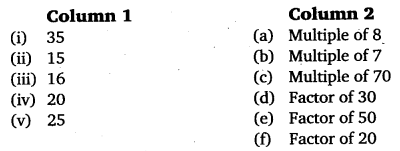
Solution:
Matching is as under :(i) → (c) ∵ 35 x 2 = 70
(ii) →(d) ∵ 30 = 15 = 2
(iii) → (a) ∵ 8 x 2 = 16
(iv)→ (f) ∵ 20 = 20 = 1
(v) → (e) ∵ 50 = 25 = 2
Ex 3.1 Class 6 Maths Question 4.
Find all the multiples of 9 upto 100.Solution:
All the multiples of 9 upto 100 are9 x 1, 9 x 2, 9 x 3, 9 x 4, 9 x 5, 9 x 6, 9 x 7, 9 x 8, 9 x 9, 9 x 10 and 9 x 11.
i. e., 9, 18, 27, 36, 45, 54, 63, 72, 81, 90 and 99.
NCERT Solutions for Class 6 Maths Chapter 3 Playing with Numbers Exercise 3.2
Ex 3.2 Class 6 Maths Question 1.
What is the sum of any two(a) Odd numbers?
(b) Even numbers?
Solution:
(a) Sum of two odd numbers is even.(b) Sum of two even numbers is even.
Ex 3.2 Class 6 Maths Question 2.
State whether the following statements are True or False :(a) The sum of three odd numbers is even.
(b) The sum of two odd numbers and one even number is even.
(c) The product of three odd numbers is odd.
(d) If an even number is divided by 2, the quotient is always odd.
(e) All prime numbers are odd.
(f) Prime numbers do not have any factors.
(g) Sum of two prime numbers is always even.
(h) 2 is the only even prime number.
(i) All even numbers are composite numbers.
(j) The product of two even numbers is always even.
Solution:
(a) False(b) True
(c) True
(d) False
(e) False
(f) False
(g) False
(h) True
(i) False
(j) True
Ex 3.2 Class 6 Maths Question 3.
The numbers 13 and 31 are prime numbers. Both these numbers have same digits 1 and 3. Find such pairs of prime numbers upto 100.Solution:
By the Sieve of Eratosthenes method find the prime numbers between 1 and 100. We find that these are2, 3, 5, 7, 11, 13, 17, 19, 23, 29, 31, 37, 41, 43, 47, 53, 59, 61, 67, 71, 73, 79, 83, 89 and 97.
Out of these, a pair of prime numbers having same digits are 13, 31; 17, 71; 37, 73, 79, 97.
Ex 3.2 Class 6 Maths Question 4.
Write down separately the prime and composite numbers less than 20.Solution:
Prime numbers less than 20 are 2, 3, 5, 7, 11, 13, 17 and 19.Composite numbers less than 20 are 4, 6, 8, 9, 10, 12, 14, 15, 16 and 18.
Ex 3.2 Class 6 Maths Question 5.
What is the greatest prime number between 1 and 10?Solution:
Prime numbers between 1 and 10 are 2, 5 and 7.∴ Greatest prime number between 1 and 10 = 7
Ex 3.2 Class 6 Maths Question 6.
Express the following as the sum of two odd primes(a) 44
(b) 36
(c) 24
(d) 18
Solution:
(a) 44 = 13 + 31(b) 36 = 5 + 31
(c) 24 = 11 +13
(d) 18 = 7+11
Note : In 1742, mathematician Goldbach had a conjecture (guess) for which he could not provide a proof. It may be stated as “Every even number greater than 4 can be expressed as the sum of two odd prime numbers”.
Ex 3.2 Class 6 Maths Question 7.
Give three pairs of prime numbers whose difference is 2.Solution:
Three pairs of prime number whose difference is 2 are 3, 5; 5, 7 and 11, 13.Note : Two prime numbers are known as twin-primes if there is one composite number between them. In other words, two prime numbers whose difference is 2 are called twin-primes.
Ex 3.2 Class 6 Maths Question 8.
Which of the following numbers are prime? ,(a) 23
(b) 51
(c) 37
(d) 26
Solution:
(a) We find that 23 is not exactly divisible by any of the prime numbers 2, 3, 5, 7 and 11 (i.e., upto half of 23). So, it is a prime number.(b) We find that 51 is divisible by 3. So, it is not a prime number.
(c) We find that 37 is not exactly divisible by any of the prime numbers 2, 3, 5, 7, 11, 13 and 17 (i.e., upto half of 37). So, it is a prime number.
(d) We find that 26 is exactly divisible by 2 and 13. So, it is not a prime number.
Ex 3.2 Class 6 Maths Question 9.
Write seven consecutive composite numbers less-than 100 so that there is no prime number between them.Solution:
Seven consecutive composite numbers less than 100 so that there is no prime number between them are 90, 91, 92, 93, 94, 95 and 96.Ex 3.2 Class 6 Maths Question 10.
Express each of the following numbers as the sum of three odd primes:(a) 21
(b) 31
(c) 53
(d) 61
Solution:
Expressing the given numbers as the sum of three odd primes, we have(a) 21 = 3 + 5 + 13
(b) 31 = 3 + 5 + 23
(c) 53 = 3 + 19 + 31
(d) 61 = 3 + 11 + 47
Ex 3.2 Class 6 Maths Question 11.
Write five pairs of prime numbers less than 20 whose sum is divisible by 5.Solution:
Prime numbers below 20 are 2, 3, 5, 7, 13, 17 and 19.Possible sum of pairs of these numbers :

Clearly, five pairs of prime numbers whose sum is divisible by 5 are 2, 3; 2, 13; 3, 7; 3,17 and 7, 13.
Ex 3.2 Class 6 Maths Question 12.
Fill in the blanks :(a) A number which has only two factors is called a
(b) A number which has more than two factors is called a
(c) 1 is neither nor
(d) The smallest prime number is
(e) The smallest composite number is
(f) The smallest even number is
Solution:
(a) Prime(b) composite
(c) prime, composite
(d) 2
(e) 4
(f) 2
NCERT Solutions for Class 6 Maths Chapter 3 Playing with Numbers Exercise 3.3
Ex 3.3 Class 6 Maths Question 1.
Using divisibility tests, determine which of the following numbers are divisible by 2; by 3; by 4; by 5; by 6; by 8; by 9; by 10; by 4; by 11 (say yes or no) :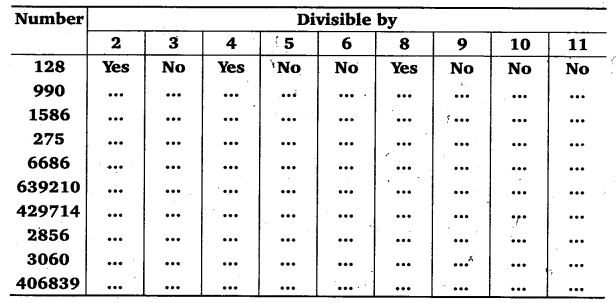
Solution:

Ex 3.3 Class 6 Maths Question 2.
Using divisibility tests, determine which of the following numbers are divisible by 4; by 8 :(a) 572
(b) 726352
(c) 5500
(d) 6000
(e) 12159
(f) 14560
(g) 21084
(h) 31795072
(i) 1700
(j) 2150
Solution:
We know that a number is divisible by 4, if the number formed by its digits in ten’s and unit’s place is divisible by 4.(a) In 572, 72 is divisible by 4. So, 572 is divisible by 4.
(b) In 726352, 52 is divisible by 4. So, it is divisible by 4.
(c) In 5500, 00 is divisible by 4. So, it is divisible by 4.
(d) In 6000, 00 is divisible by 4. So, it is divisible by 4.
(e) In 12159, 59 is not divisible by 4. So, it is not divisible by 4.
(f) In 14560, 60 is divisible by 4. So, it is divisible by 4.
(g) In 21084, 84 is divisible by 4. So, it is divisible by 4.
(h) In 31795072, 72 is divisible by 4. So, it is divisible by 4.
(i) In 1700,00 is divisible by 4. So, it is divisible by 4.
(j) In 2150, 50 is not divisible by 4. So, it is not divisible by 4.
Also, we know that a number is divisible by 8, if the number formed by its hundred’s, ten’s and unit’s places is divisible by 8.
(a) 572 is not divisible by 8.
(b) In 726352, 352 is divisible by 8. So, it divisible by 8.
(c) In 5500, 500 is not divisible by 8. So, it is not divisible by 8.
(d) In 6000, 000 is divisible by 8. So, it is divisible by 8.
(e) In 12159, 159 is not divisible by 8. So, it is not divisible by 8.
(f) In 14560, 560 is divisible by 8. So, it is divisible by 8.
(g) In 21084, 084 is not divisible by 8. So, it is not divisible by 8.
(h) In 31795072, 072 is divisible by 8. So, it is divisible by 8.
(i) In 1700, 700 is not divisible by 8. So, it is not divisible by 8.
(j) In 2150, 150 is not divisible by 8. So, it is not divisible by 8.
Ex 3.3 Class 6 Maths Question 3.
Using divisibility tests, determine which of the followingnumbers are divisible by 6 : .
(a) 297144
(b) 1258
(c) 4335
(d) 61233
(e) 901352
(f) 438750
(g) 1790184
(h) 12583
(i) 639210
(j) 17852
Solution:
We know that a number is divisible by 6, if it is divisible by 2 and 3 both.(a) Given number = 297144
Its unit’s digit is 4. So, it is divisible by 2.
Sum of its digits = 2+ 9+ 7 + 1 + 4 + 4 = 27, which is divisible by 3.
∴ 297144 is divisible by 6.
(b) Given number =1258
Its unit’s digit is 8. So, it is divisible by 2.
Sum of its digits = 1+ 2 + 5 + 8 = 16, which is not divisible by 3.
∴ 1258 is not divisible by 6.
(c) Given number = 4335 .
Its unit’s digit is 5. So, it is not divisible by 2.
∴ 4335 is also not divisible by 6.
(d) Given number = 61233
Its unit’s digit is 3. So, it is not divisible by 2.
∴ 61233 is also not divisible by 6.
(e) Given number = 901352
Its unit’s digit is 2. So, it is divisible by 2.
Sum of its digits = 9+ 0 + 1 + 345 + 2 = 20, which is not divisible by 3.
∴ 901352 is not divisible by 6.
(f) Given number = 438750
Its unit’s digit is 0. So, it is divisible by 2.
Sum of its digits = 4+ 3 + 8 + 7 + 5 + 0=27, which is divisible by 3.
∴ 438750 is divisible by 6.
(g) Given number = 1790184
Its unit’s digit is 4. So, it is divisible by 2.
Sum of its digits = 1+ 7 + 9+ 0+ 1+ 8 + 4 = 30, which is divisible by 3.
∴ 1790184 is divisible by 6.
(h) Given number = 12583 .
Its unit’s digit is 3. So, it is not divisible by 2.
∴ 12583 is not divisible by 6.
(i) Given number = 639210
Its unit’s digit is 0. So, it is divisible by 2.
Sum of its digits = 6+ 3+ 9+ 2 + 1 + 0 = 21, which is divisible by 3.
∴ 639210 is divisible by 6.
(j) Given number = 17852
Its unit’s digit is 2. So, it is divisible by 2.
Sum of its digits = 1 + 7 + 8 + 5 + 2 = 23, which is not divisible by 3.
∴ 17852 is not divisible by 6.
Ex 3.3 Class 6 Maths Question 4.
Using divisibility tests, determine which of the following numbers are divisible by 11:(a) 5445
(b) 10824
(c) 7138965
(d) 70169308
(e) 10000001
(f) 901153
Solution:
We know that a number is divisible by 11, if the difference in odd places (from the right) and the sum of its digits in even places (from the right) is either 0 or a multiple of 11.(a) Given number = 5445
Sum of its digits at odd places = 5 + 4 = 9
Sum of its digit at even places = 4 + 5 = 9
Difference of these two sums = 9 – 9 = 0
∴ 5445 is divisible by 11.
(b) Given number = 10824
Sum of its digits at odd places = 4+ 8 + 1 = 13
Sum of its digits at even places =2 + 0 =2
Difference of these two sums =13 – 2 = 11, which is a multiple of 11.
∴ 10824 is divisible by 11.
(c) Given number = 7138965
Sum of its digits at odd places = 5+ 9+ 3 + 7= 24
Sum of its digits at even places = 6+ 8 + 1 = 15
Difference of these two sums = 24 – 15 = 9, which is not a multiple of 11.
∴ 7138965 is not divisible by 11.
(d) Given number = 70169308
Sum of its digits at odd places = 8 + 3 + 6 + 0=17
Sum of its digits at even places = 0 + 9 + 1 + 7 = 17
Difference of these two sums =17 – 17 = 0
∴ 70169308 is divisible by 11.
(e) Given number = 10000001
Sum of its digits at odd places = 1 + 0 + 0 + 0 = 1
Sum of its digits at even places = 0 + 0 + 0 + 1 = 1
Difference of these two sums = 1 – 1 = 0
∴ 10000001 is divisible by 11.
(f) Given number = 901153
Sum of its digits at odd places = 3 + 1 + 0 = 4
Sum of its digits at even places = 5 + 1 + 9=15
Difference of these two sums =15 – 4 = 11,
which is a multiple of 11.
∴ 901153 is divisible by 11.
Ex 3.3 Class 6 Maths Question 5.
Write the smallest digit and the greatest digit in the blank space of each of the following numbers so that the number formed is divisible by 3 :(a) … 6724
(b) 4765 … 2
Solution:
We know that a number divisible by 3, if the sum of its digits is divisible by 3.(a) … 6724
For … 6724, we have 6 + 7 + 2 + 4 =19, we add 2 to 19, the resulting number 21 will be divisible by 3.
∴ The required smallest digit is 2.
Again, if we add 8 to 19, the resulting number 27 will be divisible by 3. .’. The required largest digit is 8.
(b) 4765 … 2
For 4765 … 2, we have 4 + 7 + 6 + 5 + 2 = 24, it is divisible by 3.
Hence the required smallest digit is 0.
Again, if we add 9 to 24, the resulting number 33 will be divisible by 3.
∴ The required largest digit is 9.
Ex 3.3 Class 6 Maths Question 6.
Write a digit in the blank space of each of the following numbers so that the number formed is divisible by 11:(a) 92 … 389
(b) 8 … 9484
Solution:
We know that a number is divisible by 11, if the difference of the sum of its digits at odd places and the sum of its digits at even places is either 0 or divisible by 11.(a) 92 … 389
For 92 … 389, sum of the digits at odd places and sum of digits at even places
= 9 + 3 + 2 = 14
= 8 + required digit + 9
= required digit+ 17
Difference between these sums
= required digit + 17 – 14
= required digit + 3
For (required digit + 3) to become 11, we must have the required digit as 8 (∵ 3+ 8 gives 11).
Hence, the required smallest digit = 8 .
(b) 8…9484
For 8 … 9484, sum of the digits at odd places
= 4 + 4 + required digit
= 8 + required digit
and sum of digits at even places
= 8 + 9 + 8 = 25
Difference between these sums
= 25 – (8 + required digit)
= 17- required digit
For (17 — required digit) to become 11 we must have the required digit as 6 (∵ 17-6 =11).
Hence the required smallest digit = 6
NCERT Solutions for Class 6 Maths Chapter 3 Playing with Numbers Exercise 3.4
Ex 3.4 Class 6 Maths Question 1.
Find the common factors of:(a) 20 and 28
(b) 15 and 25
(c) 35 and 50
(d) 56 and 120
Solution:
(a) We have, 20 = 1 x 20= 2 x 10
= 4 x 5
∴ All the factors of 20 are 1, 2, 4, 5, 10 and 20
Again, 28 = 1 x 28
28 = 2 x 14
28 = 4 x 7
∴ All the factors of 28 are 1, 2, 4, 7, 14 and 28.
Out of these 1, 2 and 4 occur in both the lists.
∴ 1, 2 and 4 are common factors of 20 and 28.
(b) We have, 15 = 1 x 15
15 = 3 x 5
∴ All the factors of 15 are 1, 3, 5 and 15.
Again, 25 = 1 x 25
25 = 5 x 5
∴ All the factors of 25 are 1, 5 and 25.
Out of these 1 and 5 occur in both the lists.
∴1 and 5 are common factors of 15 and 25.
(c) We have, 35 = 1 x 35
35 = 5 x 7
∴ All the factors of 35 are 1, 5, 7 and 35.
Again, 50 = 1 x 50
50 = 2 x 25
50 = 5 x 10
∴ All the factors of 50 are 1, 2, 5, 10, 25 and 50. ,
Out of these 1 and 5 occur in both the lists.
∴ 1 and 5 are common factors of 35 and 50.
(d) We have, 56 = 1 x 56
56 = 2 x 28
56 = 4 x 14
56 = 7 x 8
∴ All the factors of 56 are 1, 2, 4, 7, 8, 14, 28 and 56.
Again, 120 = 1 x 120
120 = 2 x 60
120 = 3 x 40
120 = 4 x 30
120 = 5 x 24
120 = 6 x 20
120 = 8 x 15
120 = 10 x 12
∴ All the factors of 120 are 1, 2, 3, 4, 5, 6, 8, 10, 12, 15, 20, 24, 30, 40, 60 and 120.
Out of these 1, 2, 4 and 8 occur in both the lists.
∴ 1, 2, 4 and 8 are common factors of 56 and 120.
Ex 3.4 Class 6 Maths Question 2.
Find the common factors of:(a) 4, 8 and 12
(b) 5, 15 and 25
Solution:
(a) We have, 4=1 x 44 = 2 x 2
∴ All the factors of 4 are 1, 2 and 4.
Again, 8 = 1 x 8
8 = 2 x 4
∴All the factors of 8 are 1, 2, 4 and 8.
Again, 12 = 1 x 12
12 = 2 x 6
12 = 3 x 4
∴ All the factors of 12 are 1, 2, 3, 4, 6 and 12.
Out of these 1, 2 and 4 occur in all the three lists.
∴ 1, 2 and 4 are common factors of 4, 8 and 12.
(b) We have, 5 = 1 x 5
∴All the factors of 5 are 1 and 5.
15 = 1 x 15
15 = 3 x 5
∴ All the factors of 15 are 1, 3, 5 and 15.
25 = 1 x 25
25 = 5 x 5
∴ All the factors of 25 are 1, 5 and 25.
Out of these 1 and 5 occur in all the three lists.
∴ 1 and 5 are common factors of 5, 15 and 25.
Ex 3.4 Class 6 Maths Question 3.
Find first three common multiples of:(a) 6 and 8
(b) 12 and 18
Solution:
(a) Multiples of 6 are 6, 12, 18, 24, 30, 36, 42, 48, 54, 60, 66, 72,…Multiples of 8 are 8, 16, 24, 32, 40, 48, 56, 64, 72,…
Out of these 24, 48, 72, … occur in both thfe lists.
∴ The first three common multiples of 6 and’8 are 24, 48 and 72.
(b) Multiples of 12 are 12, 24, 36, 48, 60, 72, 84, 96, 108, …
Multiples of 18 are 18, 36, 54, 72, 90, 108, …
Out of these 36, 72, 108, … occur in both the lists.
∴ The first three common multiples of 12 and 18 are 36, 72 and 108.
Ex 3.4 Class 6 Maths Question 4.
Write all the numbers less than 100 which are corrimon multiples of 3 and 4.Solution:
Common multiples of 3 and 4 are multiples of 3 x 4 i. e., 12.∴ Common multiples of 3 and 4 less than 100 are 12, 24, 36,48, 60, 72, 84 and 96.
Ex 3.4 Class 6 Maths Question 5.
Which of the following numbers are co-prime?(a) 18 and 35
(b) 15 and 37
(c) 30 and 415
(d) 17 and 68
(e) 216 and 215
(f) 81 and 16
Solution:
(a) Factors of 18 are 1, 2, 3, 6, 9 and 18 and, that of 35 are 1, 5, 7 and 35.∴ Common factor of 18 and 35 is 1.
Thus, 18 and 35 are co-prime.
(b) Factors of 15 are 1, 3, 5 and 15 and, that of 37 are 1 and 37.
∴ Common factor of 15 and 37 is 1.
Thus, 15 and 37 are co-prime.
(c) Since 5 is a common factor of 30 and 415.
∴ 30 and 415 are not co-prime.
(d) ∴ 68 + 17 = 4 i.e., 17 is a common factor of 17 and 68.
∴ 17 and 68 are not co-prime.
(e) Since 1 is the only common factor of 216 and 215.
∴ 216 and 215 are co-prime.
(f) Since 1 is the only common factor of 81 and 16.
∴ 81 and 16 are co-prime.
Ex 3.4 Class 6 Maths Question 6.
A number is divisible by both 5 and 12. By which other number will that number be always divisible?Solution:
Since a number is divisible by both 5 and 12.So, it is also divisible by 5 x 12 i. e., 60.
Ex 3.4 Class 6 Maths Question 7.
A number is divisible by 12. By what other numbers will that number be divisible?Solution:
Factors of 12 are 1, 2, 3, 4 and 12.Since a number is divisible by 12. So, it is also divisible by the factors of 12.
Thus, the number is also divisible by 2, 3 and 4.
NCERT Solutions for Class 6 Maths Chapter 3 Playing with Numbers Exercise 3.5
Ex 3.5 Class 6 Maths Question 1.
Which of the following statements are true?(a) If a number is divisible by 3, it must be divisible by 9.
(b) If a number is divisible by 9, it must be divisible by 3.
(c) A number is divisible by 18, if it is divisible by both 3 and 6.
(d) If a number is divisible by 9 and 10 both, then it must be , divisible by 90.
(e) If two numbers are co-primes’, at least one of them must be prime.
(f) All numbers which are divisible by 4 must also be divisible by 8.
(g) All numbers which are divisible by 8 must also be divisible by 4.
(h) If a number exactly divides two numbers separately, it must exactly divide their sum.
(i) If a number exactly divides the sum of two numbers, it must exactly divide the two numbers separately.
Solution:
Statements (b), (d), (g) and (i) are true.Ex 3.5 Class 6 Maths Question 2.
Here are two different factor trees for 60. Write the missing numbers.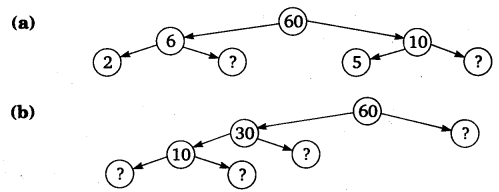
Solution:
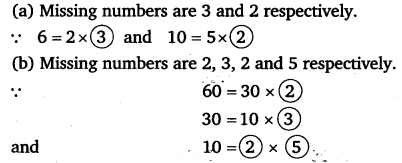
Ex 3.5 Class 6 Maths Question 3.
Which factors are not included in the prime factorisation of acomposite number?
Solution:
1 and composite numbers are not included in the prime factorisation of a composite number.Ex 3.5 Class 6 Maths Question 4.
Write the greatest 4-digit number and express it in terms of its prime factors.Solution:
The greatest 4-digit number = 9999We have,
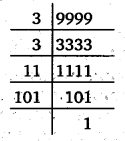
∴ 9999 = 3 x 3 x 11 x 101
Ex 3.5 Class 6 Maths Question 5.
Write the smallest 5-digit number and express it in the form of its prime factors.Solution:
Smallest 5-digit number = 10000We have,
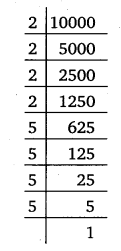
∴ 10000=2 x 2 x 2 x 2 x 5 x 5 x 5 x 5
Ex 3.5 Class 6 Maths Question 6.
Find all the prime factors of 1729 and arrange them in ascending order. Now state the relation, if any; between two consecutive prime factors.Solution:
We have,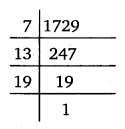
∴ 1729 = 7 x 13 x 19
Relation between two consecutive prime factors is stated as “difference between two consecutive prime factors is 6”.
Ex 3.5 Class 6 Maths Question 7.
The product of three consecutive numbers is always divisible by 6. Verify this statement with the help of some examples.Solution:
Let us consider the product of three consecutive numbers as under :
In all the products, we have 6 or 4 or 0 in the unit’s place, so each product is divisible by 2.
Also, sum of digits in these products are divisible by 3. So, each of the product is divisible by 3.
Since 2 and 3 are co-prime, so the product 2 x 3 = 6 divides each of the above products.
Thus, the product of three consecutive numbers is always divisible by 6.
Ex 3.5 Class 6 Maths Question 8.
The sum of two consecutive odd numbers is divisible by 4. Verify this statement with the help of same examples.Solution:
3 + 5 = 8 and 8 is divisible by 4.5 + 7 = 12 and 12 is divisible by 4.
7 + 9=16 and 16 is divisible by 4.
9 +11 = 20 and 20 is divisible by 4.
Ex 3.5 Class 6 Maths Question 9.
In which of the following expressions, prime factorisation has been done ? ‘(a) 24 = 2 x 3 x 4
(b) 56 = 7 x 2 x 2 x 2
(c) 70 = 2 x 5 x 7
(d) 54 = 2 x 3 x 9
Solution:
In (b) and (c) prime factorisation has been done.Ex 3.5 Class 6 Maths Question 10.
Determine if 25110 is divisible by 45.Solution:
Since 45 = 5 x 9, where 5 and 9 are co-primes.So to check the divisibility of 25110 by 45, test it for 5 and 9.
In 25110, unit’s digit = 0
So, 25110 is divisible by 5.
Sum of its digits = 2 + 5 + 1 + 1+ 0 = 9, which is divisible by 9.
So, 25110 is also divisible by 9.
Hence, 25110 is divisible by 45.
Ex 3.5 Class 6 Maths Question 11.
18 is divisible by both 2 and 3. It is also divisible by 2 x 3 = 6. Similarly, a number is divisible by both 4 and 6. Can we say that the number must also be divisible by 4 x 6 = 24 ? If not, give an example to justify your answer.Solution:
Not necessarily, as the numbers 12,36,60 etc. are each divisible by both 4 and 6. But these numbers are not divisible by 4 x 6 = 24.Ex 3.5 Class 6 Maths Question 12.
I am the smallest number, having four different prime factors. Can you find me?Solution:
Smallest four different prime numbers are 2, 3, 5 and 7.∴ Required number = 2 x 3 x 5 x 7 = 210.
NCERT Solutions for Class 6 Maths Chapter 3 Playing with Numbers Exercise 3.6
Ex 3.6 Class 6 Maths Question 1.
Find the HCF of the following numbers :(a) 18, 48
(b) 30, 42
(c) 18, 60
(d) 27, 63
(e) 36, 84
(f) 34, 102
(g) 70, 105, 175
(h) 91, 112, 49
(i) 18, 54, 81
(j) 12, 45, 75
Solution:
(a) First, we write the prime factorisation of each of the given numbers. We have,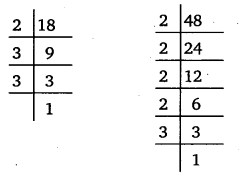
∴ 18 = 2 x 3 x 3
and 48 = 2 x 2 x 2 x 2 x 3
We find that 2 and 3 each occurs as a common factor in the given numbers at least once.
∴ Required HCF = 2 x 3 = 6
(b) First, we write the prime factorisation of each of the given numbers.
We have,
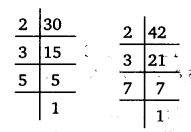
∴ 30 = 2 x 3 x 5
and 42 = 2 x 3 x 7
We find that 2 and 3 each occurs as a common factor in the given numbers at least once.
Required HCF = 2 x 3 = 6
(c) First, we write the prime factorisation of each of the given numbers.
We have,

∴ 18 = 2 x 3 x 3
and 60 = 2 x 2 x 3 x 5
We find that 2 and 3 each occurs as a common factor in
(d) 27,63
Factors of 27 are 1, 3, 9 and 27.
Factors of 63 are 1, 3, 7, 9, 21 and 63.
Common factors of 27 and 63 are 1, 3 and 9.
Highest of these common factors is 9.
∴ H.C.F. of 27 and 63 is 9.
(e) 36,84
Factors of 36 are 1, 2, 3,4, 6, 9,12, 18 and 36.
Factors of 84 are 1,2, 3,4,6,7, 12, 14,21, 28, 42 and 84.
Common factors of 36 and 84 are 1,2, 3,4, 6 and 12.
Highest of these common factors is 12.
∴ H.C.F. of 36 and 84 is 12. if) 34,102 • ‘
Factors of 34 are 1,2, 17 and 34.
Factors of 102 are 1, 2, 3,6,17, 34. 51 and 102.
∴ Common factors of 34 and 102 are 1, 2, 17 and 34.
Highest of these common factors is 34.
∴ H.C.F. of 34 and 102 is 34.
(g) 70,105,175
Factors of 70 are 1. 2, 5. 7, 10. 14, 35 and 70.
Factors of 105 are 1, 3, 5. 7. 15. 21. 35 and 105.
Factors of 175 are 1. 5, 7. 25. 35 and 175. .’. Common factors of 70, 105 and 175 are 1, 5 and 35.
Highest of these common factors is 35.
∴ H.C.F. of 70. 105 and 175 are 35.
(h) 91,112,49
Factors of 91 are 1,7, 13 and 91.
Factors of 112 are 1,2. 4. 7, 8, 14. 16. 28, 56 and 112.
Factors of 49 are 1.7 and 49.
Common factors of 91,112 and 49 are 1 and 7.
Highest of these common factors is 7.
∴ H.C.F. of 91, 112 and 49 is 7.
(i) 18,54,81
Factors of 18 are 1. 2, 3. 6, 9 and 18. Factors of 54 are 1, 2. 3, 6. 9, 18. 27 and 54.
Factors of 81 are 1. 3, 9, 27 and 81.
∴ Common factors of 18,54 and 81 are 1, 3 and 9.
Highest of these common factors is 9.
∴ H.C.F. of 18, 54 and 81 is 9.
(j) 12, 45, 75
Factors of 12 are 1, 2, 3, 4, 6 and 12. Factors of 45 are 1, 3, 5, 9, 15 and 45.
: Factors of 75 are 1, 3, 5, 15, 25 and 75.
∴ Common factors of 12,45 and 75 are 1 and 3.
Highest of these common factors is 3.
H.C.F. of 12. 45 and 75 is 3.
Ex 3.6 Class 6 Maths Question 2.
What is the H.C.F. of two consecutive :(a) numbers?
(b) even numbers?
(c) odd numbers?
Solution:
(a) The H.C.F. of two consecutive numbers is 1.(b) The H.C.F. of two consecutive even numbers is 2.
(c) The H.C.F. of two consecutive odd numbers is 1.
Ex 3.6 Class 6 Maths Question 3.
H. C.F. of co-prime numbers 4 and 15 was found as follows factorization: 4 = 2 × 2 and 15 = 3 × 5 since there is no common prime factor, so H.C.F. of 4 and 15 is 0. Is the answer correct? If not, what is the correct H.C.F?Solution:
No, the answer is not correct. The correct answer is as follows :H.C.F. of 4 and 15 is 1.
NCERT Solutions for Class 6 Maths Chapter 3 Playing with Numbers Exercise 3.7
Ex 3.7 Class 6 Maths Question 1.
Renu purchases two bags of fertilizer of weights 75 kg and 69 kg. Find the maximum value of weight which can measure the weight of the fertilizer e×act number of times.Solution:
Factors of 75 are 1, 3, 5, 15, 25 and 75.Factors of 69 are 1, 3, 23 and 69.
∴ Common factors of 75 and 69 are 1 and 3.
Highest of these common factors is 3.
∴ H.C.F. of 75 and 69 is 3.
Hence, the maximum value of weight which can measure the weight of the fertilizer e×act number of times is 3 kg.
Ex 3.7 Class 6 Maths Question 2.
Three boys step off together from the same spot. Their steps measure 63 cm, 70 cm, and 77 cm, respectively. What is the minimum distance each should cover so that all can cover the distance in complete steps?Solution:

∴ L.C.M. of 63, 70 and 77
= 2 × 3 × 3 × 5 × 7 × 11 = 6930.
Hence, the minimum distance each should cover so that all can cover the distance in complete steps is 6930 cm.
Ex 3.7 Class 6 Maths Question 3.
The length, breadth, and height of a room are 825 cm, 675 cm, and 450 cm, respectively. Find the longest tape which can measure the three dimensions of the room exactly.Solution:
Factors of 825 are 1, 3, 5, 11, 15, 25, 33, 55,75,165, 275 and 825.Factors of 675 are 1, 3, 5,9,15, 25, 27,45,75, 135, 225 and 675.
Factors of 450 are 1,2,3,5,6,9,10,15,18,25, 30,45, 50, 75, 90, 150, 225 and 450.
∴ Common factors of 825, 675 and 450 are 1,3,5,15, 25 and 75.
Highest of these common factors is 75.
Hence, the length of the longest tape which can measure the three dimensions of the room exactly is 75 cm.
Ex 3.7 Class 6 Maths Question 4.
Determine the smallest 3-digit number which is exactly divisible by 6, 8 and 12.Solution:

∴ L.C.M. of 6, 8 and 12 = 2 × 2 × 2 × 3 = 24. Multiples of 24 are 24,48,72,96,120,144,
Hence, the smallest 3-digit number which is exactly divisible by 6, 8 and 12 is 120.
Ex 3.7 Class 6 Maths Question 5.
Determine the largest 3-digit number exactly divisible by 8, 10 and 12.Solution:

∴ L.C.M. of 8,10 and 12 = 2×2×2×3×5
= 120.
Multiples of 120 are :
120 × 1 = 120,120 × 2 = 240,120 × 3 = 360,120 × 4 = 480,120 × 5 = 600,120 × 6 = 720,120 × 7 = 840,
120 × 8 = 960,120 × 9 = 1080,
Hence, the largest 3-digit number exactly divisible by 8, 10 and 12 is 960.
Ex 3.7 Class 6 Maths Question 6.
The traffic lights at three different road crossings change after every 48 seconds, 72 seconds and 108 seconds respectively. If they change simultaneously at 7 am at what time will they change simultaneously again?Solution:
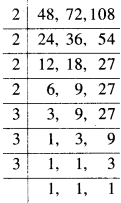
∴ L.C.M. of 48,72 and 108 = 2 × 2 × 2 × 2 × 3 × 3 × 3 = 432.
432 seconds = 7 min 12 seconds.
Hence, they will change simultaneously again after 7 min 12 seconds from 7 a.m.
Ex 3.7 Class 6 Maths Question 7.
Three tankers contain 403 liters, 434 liters and 465 liters of diesel respectively. Find the ma×imum capacity of a container that can measure the diesel of the three containers e×act a number of times.Solution:
Factors of 403 are 1, 13, 31 and 403. Factors of 434 are 1, 2, 7, 14, 31, 62, 217 and 434.Factors of 465 are 1, 3, 5, 15, 31, 93, 155 and 465.
Common factors of 403,434 and 465 are 1 and 31.
Highest of these common factors is 31.
∴ H.C.F. of 403. 434 and 465 is 31.
Hence, the maximum capacity of the container that can measure the diesel of the three containers an e×act number of times is 31 litres.
Ex 3.7 Class 6 Maths Question 8.
Find the least number which when divided by 6, 15 and 18 leave remainder 5 in each case.Solution:
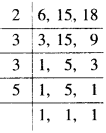
∴ L.C.M. of 6, 15 and 18 = 2 × 3 × 3 × 5 = 90.
Hence, the required number is 90 + 5 i.e., 95.
Ex 3.7 Class 6 Maths Question 9.
Find the smallest four digit number which is divisible by 18, 24 and 32.Solution:
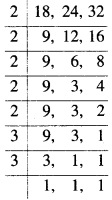
∴ L.C.M. = 2 × 2 × 2 × 2 × 2 × 3 × 3 = 288.
Multiples of 288 are :
288 × 1 = 288, 288 × 2 = 576, 288 × 3 = 864, 288×4= 1152,
Hence, the smallest four digit number which is divisible by 18, 24 and 32 is 1152.
Ex 3.7 Class 6 Maths Question 10.
Find the L.C.M. of the following numbers:(a) 9 and 4
(b) 12 and 5
(c) 6 and 5
(d) 15 and 4.
Observe a common property in the obtained L.C.M.s. Is L.C.M. the product of two numbers in each case?
Solution:
(a) 9 and 4
∴ L.C.M. of 9 and 4 = 2 × 2 × 3 × 3 = 36 (= 9 × 4).
(b) 12 and 5

∴ L.C.M. of 12 and 5 = 2×2×3×5 = 60 (= 12 × 5).
(c) 6 and 5

∴ L.C.M. of 6 and 5 = 2×3×5 = 30 (= 6 × 5).
(d) 15 and 4

∴ L.C.M. of 15 and 4 = 2 × 2 × 3 × 5 = 60 (=15×4).
We observe a common property in the obtained L.C.M.’s that L.C.M. is the product of two numbers in each case.
Ex 3.7 Class 6 Maths Question 11.
Find the L.C.M. of the following numbers in which one number is the factor of the other.(a) 5, 20
(b) 6, 18
(c) 12, 48
(d) 9, 45.
What do you observe in the results obtained?
Solution:
(a) 5, 20Prime factorisations of 5 and 20 are as follows: 5 = 5
20 = 2 × 2 × 5 ∴ L.C.M. of 5 and 20
=2×2×5 = 20.
(b) 6, 18
Prime factorisations of 6 and 18 are as follows:
6 = 2×3 18 = 2×3×3
∴ L.C.M. of 6 and 18 = 2×3×3 = 18.
(c) 12, 48
Prime factorisations of 12 and 48 are as follows:
12 = 2 × 2 × 3
48 = 2×2×2×2×3
∴ L.C.M. of 12 and 48 = 2 × 2 × 2 × 2 × 3 = 48.
(d) 9, 45
Prime factorisations of 9 and 45 are as follows:
9 = 3×3
45 = 3 × 3 × 5
∴ L.C.M. of 9 and 45 = 3 × 3 × 5 = 45.
In the results obtained, we observe that L.C.M. of the two numbers in which one number is the factor of the other is the greater number.
NCERT Class 6 Maths
Class 6 Maths Chapters | Maths Class 6 Chapter 3
NCERT Solutions for Class 6 Maths
NCERT Solutions of Maths Class 6 Chapter-wise
Chapter-wise NCERT Solutions for Class 6 Maths
-
NCERT Solutions For Class 6 Maths Chapter 1 Knowing Our Numbers
NCERT Solutions For Class 6 Maths Chapter 2 Whole Numbers
NCERT Solutions For Class 6 Maths Chapter 3 Playing With Numbers
NCERT Solutions For Class 6 Maths Chapter 4 Basic Geometrical Ideas
NCERT Solutions For Class 6 Maths Chapter 5 Understanding Elementary Shape
NCERT Solutions For Class 6 Maths Chapter 6 Integers
NCERT Solutions For Class 6 Maths Chapter 7 Fractions
NCERT Solutions For Class 6 Maths Chapter 8 Decimals
NCERT Solutions For Class 6 Maths Chapter 9 Data Handling
NCERT Solutions For Class 6 Maths Chapter 10 Mensuration
NCERT Solutions For Class 6 Maths Chapter 11 Algebra
NCERT Solutions For Class 6 Maths Chapter 12 Ratio and Proportion
NCERT Solutions For Class 6 Maths Chapter 13 Symmetry
NCERT Solutions For Class 6 Maths Chapter 14 Practical Geometry
NCERT Solutions for Class 6 to 12
-
NCERT Solutions for Class 6 All Subjects
NCERT Solutions for Class 7 All Subjects
NCERT Solutions for Class 8 All Subjects
NCERT Solutions for Class 9 All Subjects
NCERT Solutions for Class 10 All Subjects
NCERT Solutions for Class 11 All Subjects
NCERT Solutions for Class 12 All Subjects

Post a Comment
इस पेज / वेबसाइट की त्रुटियों / गलतियों को यहाँ दर्ज कीजिये
(Errors/mistakes on this page/website enter here)